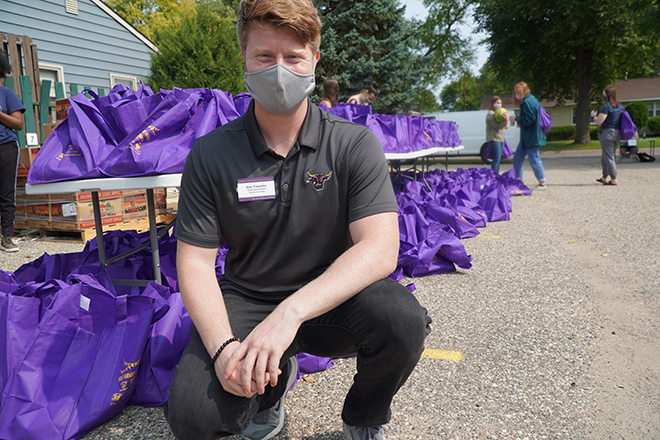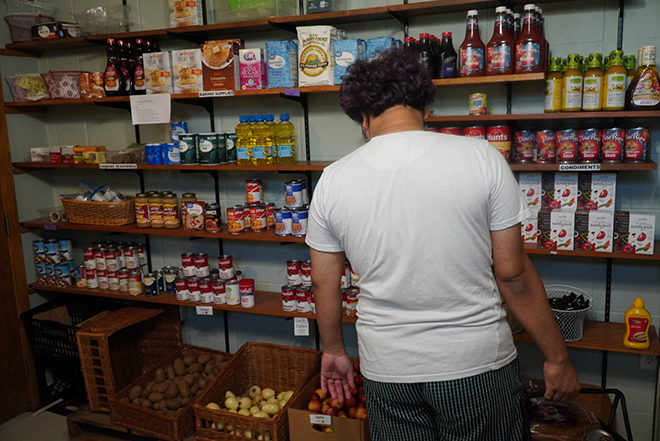Ellen is much like every other student at Minnesota State Mankato. She’s a full-time student in interdisciplinary studies, has a part-time job in retail, a scholarship and is on track to graduating in a couple of years.
But Ellen has been hiding a secret from her friends, family, classmates and professors. Her secret is that she is food insecure. And there are many others on campus like her—more than one might think.

Food insecurity, defined by the University’s Department of Sociology, is a lack of reliable access to sufficient quantities of affordable food. Students facing food insecurity may not have enough money, reliable transportation, access or time to get the food they need.
A study done at Minnesota State Mankato by the 2018 Sociology in Action class found that two-thirds of students face food insecurity in some way. The national average is 47 percent in a four-year university.
It’s been part of Ellen’s college life since its start.
“When I started college, my parents said they’d help pay for groceries and that they’d help pay for school, but I never got any help from them,” she says. “I didn’t have a job for a while when I first started college.
Money was tight, and even when I got a job, I just couldn’t make enough money to afford things, especially food.”
Students such as Ellen have faced increasing tuition rates, high costs of living and struggles with balancing work and school. Something often has to give— and it’s often getting enough to eat.
Now and Then
In 1980, when the minimum wage in Minnesota was $2.90, the average annual rate for tuition and fees at Minnesota State Mankato was $714. It would take a college student during that time 246.2 hours of working to pay for school—about a summer’s worth of working a part-time job.
By contrast, the state’s minimum wage in 2020 is $10. With tuition and fees averaging $8,521 per year, it would take a Minnesota State Mankato student half a year of working part-time to pay off their yearly cost of education. And the expenses don’t end there.
Ellen has found that supporting herself financially has become increasingly difficult each year she attends college. To cut costs, Ellen had no choice but to cut back on food.
“I remember, there was one night specifically last January, I remember driving home from work and wondering if I could find enough coins in my car to go buy some ramen from the store so I could eat,” she says.
Solutions on Campus
Early in the 2019-2020 school year, Ellen learned of a number of resources at the University and in the community to help meet her nutritional needs. After applying for the Supplemental Nutrition Assistance Program (SNAP), where students can get help through monthly food benefits and by the community’s food shelf, she found herself improving in her academics and health.
Ellen at first assumed she was the only one facing food insecurity. After talking with advisors and friends, however, she realized that this is an ongoing problem faced by many students.
“I guess I didn’t realize that it wasn’t just me who was having this problem. Knowing now that there are ways to get help, it makes it seem a little bit less intimidating and scary,” she says.
Cher Vang, a senior at Minnesota State Mankato can relate. She too found it difficult to balance work, life and school while also having a nutritious diet.
“Most of the time, it’s hard finding food. And a lot of my friends too, they’re also in the same boat. I actually had an upper classman reach out to me and tell me about some of the resources on campus,” says Vang.
One such resource was Campus Kitchen.
From harvesting, storing, packaging and delivering food, Campus Kitchen provides meals for agencies who help people find food.
“Any day you need food you can get access to it, says Karen Anderson, the manager of the Campus Kitchen.
“All you do is you come through the door. You can pick up bread at the bread cart, walk through the Campus Kitchen, open the fridge and take a baked potato or a PB and J and walk straight out. You don’t need to talk to anybody, no questions asked.”
Another important resource for food insecure students at the University is the student-run Campus Cupboard hosted by a nearby Lutheran ministry.
Campus Cupboard offers a free food pantry for students every Tuesday.
“It’s nice to have that source and to know that once a week I’ll have food in my pantry and I can get those other supplemental things,” says Laura Soland, a student volunteer at Campus Cupboard. “That’s one of the things we push is supplemental, even if you are capable of getting groceries, you can still come here.”

International students are not qualified for food assistance programs such as SNAP and are limited to working 20 hours a week on campus. Having a resource like Campus Cupboard is beneficial for many international students whose families may only have enough to pay for their tuition.
“I have suffered from bouts of food insecurity during times when family couldn’t send me the money that I need to get by,” says PJ Gurung, a student from Nepal. “I had $7 that I had to stretch out for two weeks.
That’s when I went to all of the free events on campus with free snacks and free food and the [Campus Cupboard].”
Minnesota State Student Association president Anisa Omar says student government has convened the student basic needs committee – a committee dedicated to specifically helping students facing both food and housing insecurity.
“My intentions for the committee is to have them start volunteering at the Campus Cupboard and Campus Kitchen, have them work closely with Community Engagement to see how we as Student Government
can assist them better, what it is that they need from us, and how we can help them get to where they need so they can help better themselves as students,” says Omar.
Contributions to Campus Cupboard during the Spring 2020 pandemic increased by thousands of pounds of food. Specifically, donations from Jan. 1 to mid-March amounted to 622 pounds of food. Since the early closing of classes to mid-July donations amounted to 5073 pounds.
Staff and faculty also contribute – mostly as advisors in the emergency grant program, where food insecure students can apply for funds to buy groceries.
Faculty also work in other unique ways to help students. This year the Annual Giving office which provides
money in scholarships, emergency aid, grants, etc. hosted two fundraising initiatives to raise money for Campus Kitchen.
Resources and Opportunities
Helping students with food insecurities has been a growing mission at the University. In addition to supporting direct access to food sources such as Campus Kitchen, the University has emergency financial help available, help that is sustained by donations, grants, the University Foundation, and University support.
The MAV Cares Emergency Grant Program has been helping students get through financial hardships since 2017. During the spring months of the coronavirus pandemic, donors contributed nearly $90,000 to the Campus Drive, coordinated by Annual Giving, which helped domestic, graduate, and international students.
In addition, two large gifts came in totaling $121,000 that was used to establish the University’s first emergency grant fund endowment, which will provide annual support to emergency grants. For more information, visit engage.mnsu.edu/MAVCares.
Speak Your Mind